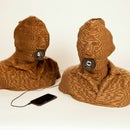Introduction: Wood Headphones Using 123D Catch + SolidWorks + ShopBot.
Wood has been know to have a great warm tonal quality for music. It only makes sense then to craft a pair of headphones from wood.
This tutorial illustrates how to create a pair of functioning headphones from wood.
I used:
Software:
-an iPad with Autodesk 123D Catch software to capture my head profile (free 123D Catch download)
*you may use a digital camera & Autodesk 123D Catch for online instead
-SolidWorks CAD software to model the headphones
-Adobe Illustrator software (free Illustrator trial)
Materials:
-12" x 7" x 0.85" thick walnut lumber
-1" thick high density gray foam (I purchased at Canal Rubber in NYC)
-speakers: 2X 40mm 0.1W round speaker drivers from Digikey.com, model number GF0401M-ND
-RCA jacks: 2X barrel jacks from Digikey.com, model number CP-1413-ND
-3' long 1/8" stereo to dual phono Y-cable at Radioshack
-4" of 20 gauge insulated wire
-2x brass hinges 3/4" x 11/16" at HomeDepot
-I reference my friend John's great 13:30 Printable Headphone tutorial at Thingiverse for the audio components
Tools:
-ShopBot CNC router
-portable power drill or drill press
-soldering iron
-wire cutter/stripper
Other:
-a buddy to assist you with your 123D Catch
Step 1: 123D Catch Your Head
As a product designer, I've worked on my fair share of headphones. Head profiles come in an infinite number of sizes & shapes. I wanted to create a pair of headphones that fit my dome perfectly. By using 123D Catch, I created an accurate CAD representation of my head.
Using the iPad (or digital camera) open the Autodesk 123D Catch app. Have a buddy take photos of your head. Your photographer should start at a low angle & progressively increase the height of the camera. They should move around your head in about 15-20 degree increments for each photo. Use the maximum of the 30 allotted photos for a more accurate catch. Hold your pose as still as possible for the best results.
My face resulted in looking a bit warped, but my head profile was decent enough to model headphones around.
Step 2: Import Your Head Into SolidWorks
Download the STL file off of the 123D Catch website. The STL file imported about 50 times the size of a normal head, so I had to scale it down. Using a ruler & looking in a mirror, I measure the width of my head (ear to ear & top to chin). In SolidWorks, I created a sketch on the front plane of a rectangle with my head dimensions. I then scaled the STL down so my face fit inside of the rectangle. SolidWorks does not make it easy to scale STL data. It does not preview the scale while in the feature, so it was a tedious task of scaling, refreshing & scaling again until it was the correct size.
Step 3: Build Your Headphones in SolidWorks
Use your head as reference for earcup placement & headband profile. Build the wood earcups so that they are almost touching your head since the foam will compress & the band will flex a little. I created a "U" key feature for the foam earpads to attach to the earcups.
I am not going to go into detail as to all of the necessary steps for creating the headphones, but the SolidWorks website has numerious tutorials if you need some assistance.
Create a SolidWorks drawing with all of your parts laid out how they will be cut on the CNC. Save the linework out as Illustrator files.
Step 4: Layout Linework in Illustrator
Open the AI files in Illustrator & make a copy of the earcup linework. Position the two earcups within the headband profile for most efficient use of the the wood. Copy & paste a duplicate for the foam earpad linework as well. Turn all of the linework to 0.001mm stroke & save out as AI files.
Step 5: Assign Cut Depths to Layers in PartWorks
Using the ShopBot native software, PartWorks, assign each level of cut depth to its own layer. There are four levels of elevation for the earcup parts. The headband & foam earpads are profile cuts, so there is only one layer for those parts. Add tabs to the profile cuts so the parts don't dislodge when cutting. Follow the ShopBot guide for cutting hardwood.
Step 6: Cut the Parts Out With ShopBot
Foam earpads:
I was mildly successful in attempting to cut out the 2 foam earpads with the ShopBot. I compressed the foam down onto the ShopBot bed by screwing down a thin piece of plywood. I was hoping the CNC bit would cut cleaner if the foam was more dense. The inside profile came out really clean, but the outer edge of the circle resulted in being pretty rough & torn looking. After cleaning the edges up with a fabric scissors, I rather like the aesthetic though.
Wood earcups & headband:
Screw down the piece of walnut securely to the ShopBot bed. Send the linework with the top level of the earcups first, then the second layer & last the third fromt the top. Then send the the profile linework of the earcups as well as the headband.
Step 7: Finishing Work
Detach the parts by using a cutting blade on a Dremel. Use a medium grit sandpaper (around 220) & sand off the tabs. Measure the diameter of the RCA input jacks & drill a hole in bottom of each earcup so they fit.
Step 8: Solder the Drivers
Cut the 20 gauge insulated wire into four 1" long pieces. Strip the ends of the wires & solder two wires to each driver. Cut the other ends of the wires so that when soldered to the RCA jacks, the components fit into the cavity of the earcups. Plug the Y-cable into the RCA jacks, then plug the 1/8" jack into an audio source. If everything was soldered correctly, the drives should produce sound.
Step 9: Assemble the Parts & Rock Out
You'll have to remove the drivers to attach the earcups to the headband with the hinges. Drill pilot holes for the small screws for each hinge. Slide the driver assembly back into the earcup cavity.
Push the foam earpads onto the earcups & rock out to some sounds of WOODstock, ha.

Second Prize in the
A/V Contest

Finalist in the
Instructables Design Competition

Participated in the
Holiday Gifts Contest













